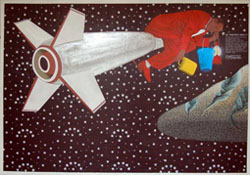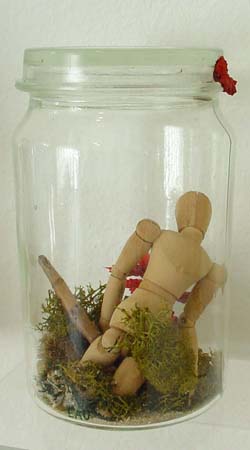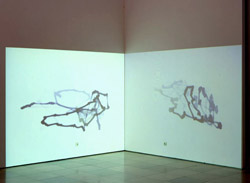| Water | Air | Food |
The exhibition-sites of the trilogy are until July 2010 in a dynamic procedure and will be relaunched periodicly. |
| Water
|
| A river must flow, otherwise he's stinking. Arabic Proverb |
February 5 - March 20, 2010
|
Up until the modern age, air and water were considered free for everyone; but due to the widespread capitalisation of once freely accessible resources, these basic necessities are now levied as multi-milliard-dollar cost factors in western tax systems. Nor have most cultures historically linked land to personal ownership; tilling and animal husbandry proceeded on the basis of temporary allotment, with allocation criteria collectively discussed according to the general need. The institution of land rights as legally secure assets was and continues to be one of the most important tools of modern imperialism. Today, the circulation of food is embedded in a gigantic transport and subsidies establishment, administratively controlled by state regulations. Syndicates and corporations pervert the food quality and, at the same time, virtually copyright animal and plant goods once considered common resources. |
Our western educational systems and our air, food, and water production processes are so little geared towards optimal human usage that we really have no right to call for imitation in other parts of the world. Heating and cooling rooms by burning fossil fuels causes incalculable environmental harm. Chemistry introduced by man into the collective food circulation system has already begun to spawn its own maladies. And today in central Europe, water must be reprocessed and sold in plastic bottles made from recycled granules in order to meet the demands of the mass market. |
||
Chéri Samba - Ou trouvez l'eau? |
On the other hand, one could argue that water treatment has never before been possible for so many people, that the air pollution sins of the past have been analysed for years and will be rectified before long, and that new forms of food distribution and hygiene are adequate to meet the demands of enormous global population growth. If that were true, vociferous calls for compensation for a global catastrophe would seem unproductive. Why, after all, should a central European taxpayer now have to answer for the development concerns of emerging countries – as was recently demanded in Copenhagen – when he himself is still burdened with the repercussions of his own country’s former environmental sins? He himself did not commit these sins, and forcing him to pay for them is not an effective way to implicate him in a collective guilt. It is easy to imagine an abundance of causes for conflict, and yet no one can say what will really happen. Will we, perhaps, fight fewer wars over water than now feared because a great mass of people from all around the world comes together to stop the destructive exploitation of the earth? There is, after all, still poetry to consider – the beauty and inscrutability of water, the exuberance of still-lifes. Pheasant and quince still exist. Air is wind and cloud, carrier of bird and balloon. What positions do individual artists take on this issue? |
Malam was one of the first artists to broach the topic of foodstuff-burning engines in his art. He worked a plaster sculpture of a human into a motorcycle frame, head squeezed through the front fork, body studded with syringes, cannulas, enema nozzles, crutches, microchips, blood, and pharmaceutical packaging. Today, the gruesomely forceful work is displayed in a German collection. Nicole Guiraud captures the four elements in preserving jars, representatives of Fire, Earth, Wind, and Water that figuratively decay in their own metaphors. Dalila Dalleas turns from biting social commentary towards painting cloud formations. Chéri Samba flies to outer space on a rocket in search of water, equipped only with a kerosene lamp, a bucket, and a jerry can. His work was displayed at the 2007 Venice Biennale and in our gallery. Daniel Jojo Schrade shows two young Africans watching a spaceship flying through the air in front of them and calls it The Afronauts. George Osodi burned himself onto the memory of many documenta visitors with a film about the Niger Delta, an area where pollution, criminalisation, and civil war form an unholy alliance. In our last exhibition, he condemned the locomotion-combustion frenzy in Nigeria with his powerful pictures of local accidents. |
||
Nicole Guiraud - The Four Elements - Water |
For Ralf Schmerberg, the 1992 Earth Summit in Rio de Janeiro served as inspiration to create the Tribe of White Warriors, an ambitious photo project that took two years to complete. The exhibition’s extraordinary success over the years justifies yet another look at the powerful images. Goddy Leye pokes fun at “We Are the World” and, in his own video of the same name, inserts himself among pineapples, bananas, and melons. He smacks his lips and sings with joy, consciously defying the image many Germans have of a suffering Africa. |
The Exhibitions Existing works from the past few years constitute the curatorial foundation of the exhibitions, though the artists were also asked to create new pieces expressing their current vision of the Water, Air, Food theme. |
||
 |
||
Pierre Granoux - The Luck |
In addition to sales and solo exhibitions, a third main pillar of the gallery’s work is the curation of (mostly) survey-style exhibitions outside its own walls, primarily for cultural associations and institutions. This cycle of exhibitions represents another tender offer: for gallery visitors, it offers the possibility to review individual pieces from the past years one last time, and for artists new to the program, it offers the opportunity to make a memorable first impression with a spectacular individual piece. Another aspiration of ours is to cooperate with other galleries and incorporate Africa-oriented approaches into a global vision, much like the legendary Around and Around exhibition in Douala or the Balance! exhibition during the G8 Summit in Heiligendamm. Peter Herrmann, December 2009 |
| Works
|
|
Georg Osodi - Toilets |
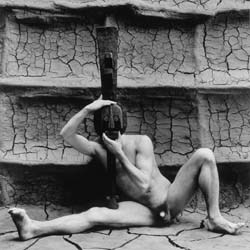 |
Ralf Schmerberg The Tribe of the White Warriors Motiv No. 21 Mask of a Waterspirit Ijo - Nigeria |
Angelika Böck - North East >> |
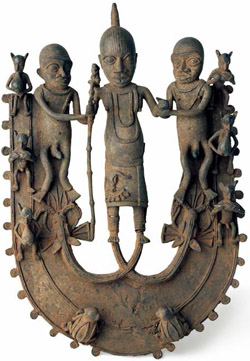 |
Relief. King with legs of a fish |
| Links
|
| Air |
| Press
|
 |
Video - Documentation of the exhibition |
| Comments
|
| External Motivs | Water
|
Relief. King of Benin with legs in the form of hingemouth fish . 17th century
|
![]()

